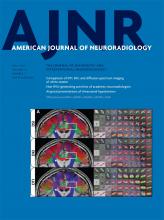Index by author
Ramalho, J.
- Patient SafetyOpen AccessGadolinium-Based Contrast Agent Accumulation and Toxicity: An UpdateJ. Ramalho, R.C. Semelka, M. Ramalho, R.H. Nunes, M. AlObaidy and M. CastilloAmerican Journal of Neuroradiology July 2016, 37 (7) 1192-1198; DOI: https://doi.org/10.3174/ajnr.A4615
Ramalho, M.
- Patient SafetyOpen AccessGadolinium-Based Contrast Agent Accumulation and Toxicity: An UpdateJ. Ramalho, R.C. Semelka, M. Ramalho, R.H. Nunes, M. AlObaidy and M. CastilloAmerican Journal of Neuroradiology July 2016, 37 (7) 1192-1198; DOI: https://doi.org/10.3174/ajnr.A4615
Reiser, M.F.
- NeurointerventionYou have accessPrediction of Stent-Retriever Thrombectomy Outcomes by Dynamic Multidetector CT Angiography in Patients with Acute Carotid T or MCA OcclusionsK.M. Thierfelder, W.H. Sommer, B. Ertl-Wagner, S.E. Beyer, F.G. Meinel, W.G. Kunz, G. Buchholz, M.F. Reiser and H. JanssenAmerican Journal of Neuroradiology July 2016, 37 (7) 1296-1302; DOI: https://doi.org/10.3174/ajnr.A4694
Rinkel, G.J.E.
- NeurointerventionOpen AccessThinner Regions of Intracranial Aneurysm Wall Correlate with Regions of Higher Wall Shear Stress: A 7T MRI StudyR. Blankena, R. Kleinloog, B.H. Verweij, P. van Ooij, B. ten Haken, P.R. Luijten, G.J.E. Rinkel and J.J.M. ZwanenburgAmerican Journal of Neuroradiology July 2016, 37 (7) 1310-1317; DOI: https://doi.org/10.3174/ajnr.A4734
Riquelme, C.
- EDITOR'S CHOICENeurointerventionYou have accessEndovascular Management of Tandem Occlusion Stroke Related to Internal Carotid Artery Dissection Using a Distal to Proximal Approach: Insight from the RECOST StudyG. Marnat, I. Mourand, O. Eker, P. Machi, C. Arquizan, C. Riquelme, X. Ayrignac, A. Bonafé and V. CostalatAmerican Journal of Neuroradiology July 2016, 37 (7) 1281-1288; DOI: https://doi.org/10.3174/ajnr.A4752
The authors analyzed all carotid artery dissection tandem occlusion strokes and isolated anterior circulation occlusions from their ongoing prospective stroke data base. For carotid artery dissection, the revascularization procedure consisted of initial distal recanalization by a stent retriever in the intracranial vessel. Following assessment of the circle of Willis, ICA stent placement was only performed in case of insufficiency. Two hundred fifty-eight patients with an anterior circulation stroke were analyzed, including 20 with carotid artery dissection–related occlusion. Only 5 carotid artery dissections (25%) necessitated cervical stent placement. No early ipsilateral stroke recurrence was recorded, despite the absence of stent placement in 15 patients (75%) with carotid artery dissection. Mechanical endovascular treatment of carotid artery dissection tandem occlusions is safe and effective compared with isolated anterior circulation occlusion stroke therapy. The authors favor a complete evaluation of the circle of Willis in these patients, which requires a contralateral femoral puncture, allowing selective contralateral common carotid and vertebrobasilar catheterizations.
Rizzo, M.
- FELLOWS' JOURNAL CLUBAdult BrainYou have accessAtypical Presentations of Intracranial Hypotension: Comparison with Classic Spontaneous Intracranial HypotensionA.A. Capizzano, L. Lai, J. Kim, M. Rizzo, L. Gray, M.K. Smoot and T. MoritaniAmerican Journal of Neuroradiology July 2016, 37 (7) 1256-1261; DOI: https://doi.org/10.3174/ajnr.A4706
The authors evaluated the clinical records and neuroimaging of patients with spontaneous intracranial hypotension from September 2005 to August 2014. Patients with classic spontaneous intracranial hypotension (n = 33) were compared with those with intracranial hypotension with atypical clinical presentation (n = 8). There was no significant difference in dural enhancement, subdural hematomas, or cerebellar tonsil herniation. Patients with atypical spontaneous intracranial hypotension had significantly more elongated anteroposterior midbrain diameter compared with those with classic spontaneous intracranial hypotension, and shortened pontomammillary distance. In this population, patients with atypical spontaneous intracranial hypotension showed a more chronic syndrome compared with classic spontaneous intracranial hypotension, more severe brain sagging, lower rates of clinical response, and frequent relapses.
Robertson, R.
- Pediatric NeuroimagingOpen AccessBrain Injury in Neonates with Complex Congenital Heart Disease: What Is the Predictive Value of MRI in the Fetal Period?M. Brossard-Racine, A. du Plessis, G. Vezina, R. Robertson, M. Donofrio, W. Tworetzky and C. LimperopoulosAmerican Journal of Neuroradiology July 2016, 37 (7) 1338-1346; DOI: https://doi.org/10.3174/ajnr.A4716
Romano, D.G.
- NeurointerventionYou have accessHemodynamic and Anatomic Variations Require an Adaptable Approach during Intra-Arterial Chemotherapy for Intraocular Retinoblastoma: Alternative Routes, Strategies, and Follow-UpE. Bertelli, S. Leonini, D. Galimberti, S. Moretti, R. Tinturini, T. Hadjistilianou, S. De Francesco, D.G. Romano, I.M. Vallone, S. Cioni, P. Gennari, P. Galluzzi, I. Grazzini, S. Rossi and S. BraccoAmerican Journal of Neuroradiology July 2016, 37 (7) 1289-1295; DOI: https://doi.org/10.3174/ajnr.A4741
Rossi, S.
- NeurointerventionYou have accessHemodynamic and Anatomic Variations Require an Adaptable Approach during Intra-Arterial Chemotherapy for Intraocular Retinoblastoma: Alternative Routes, Strategies, and Follow-UpE. Bertelli, S. Leonini, D. Galimberti, S. Moretti, R. Tinturini, T. Hadjistilianou, S. De Francesco, D.G. Romano, I.M. Vallone, S. Cioni, P. Gennari, P. Galluzzi, I. Grazzini, S. Rossi and S. BraccoAmerican Journal of Neuroradiology July 2016, 37 (7) 1289-1295; DOI: https://doi.org/10.3174/ajnr.A4741
Royalty, K.
- NeurointerventionOpen AccessC-Arm Conebeam CT Perfusion Imaging in the Angiographic Suite: A Comparison with Multidetector CT Perfusion ImagingK. Niu, P. Yang, Y. Wu, T. Struffert, A. Doerfler, S. Schafer, K. Royalty, C. Strother and G.-H. ChenAmerican Journal of Neuroradiology July 2016, 37 (7) 1303-1309; DOI: https://doi.org/10.3174/ajnr.A4691








